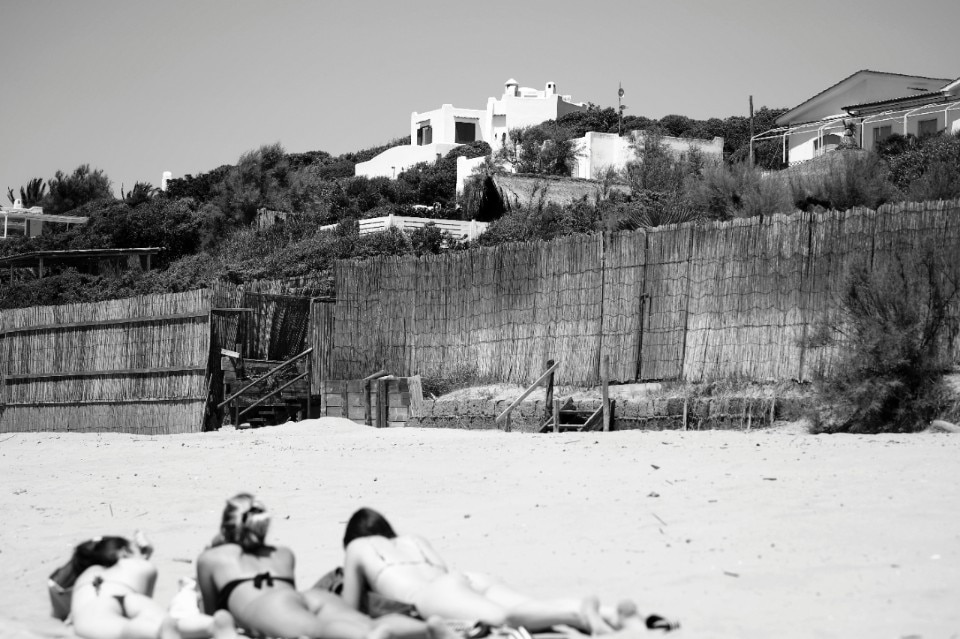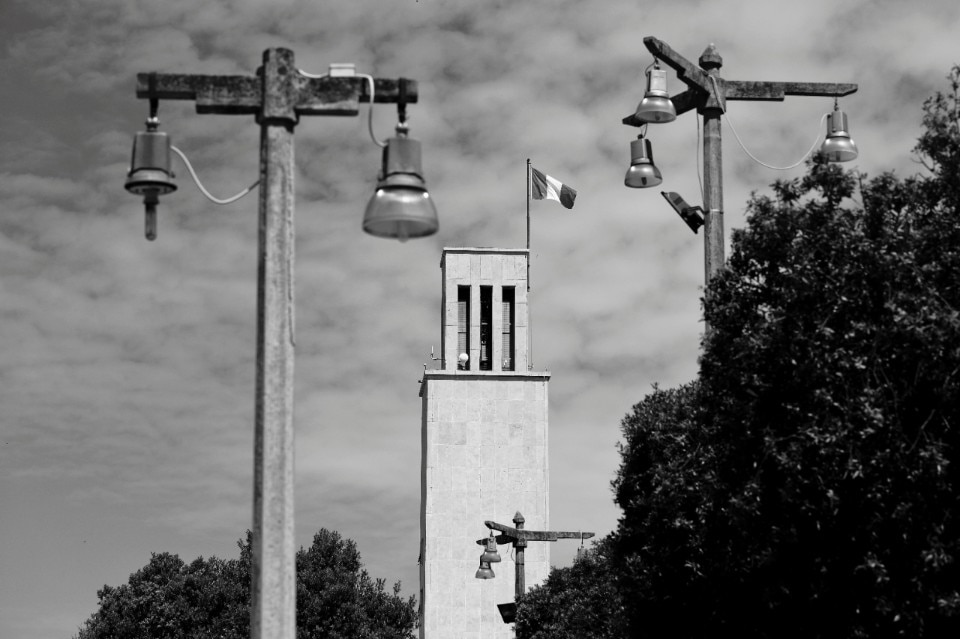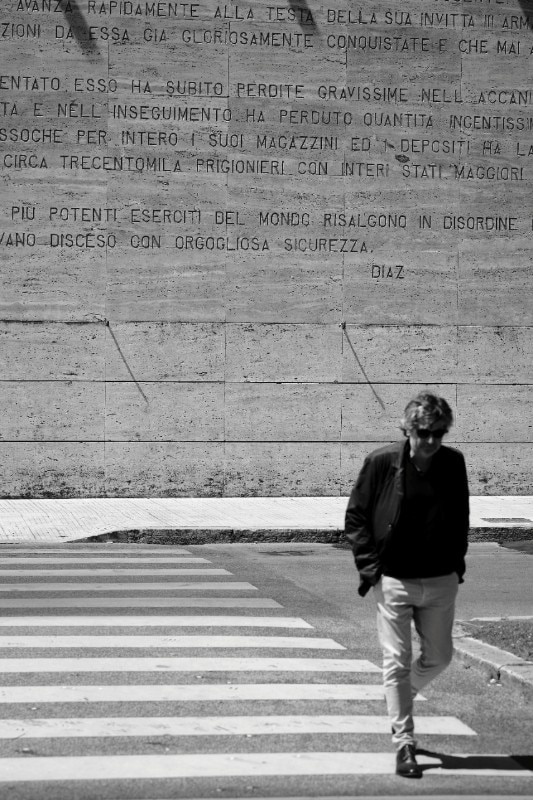
The Trafic parquet collection: a new language for spaces
Designers Marc and Paola Sadler draw on now-extinct urban scenarios to create an original and versatile product for Listone Giordano.
- Sponsored content
This article will be published in Domus 1082, on newsstands in September 2023.
In the beginning there was the story, and like every story, it all started by chance, or rather on a whim. “Faites-moi une petite folie,” wrote Countess Nathalie Volpi di Misurata to the Milanese architect Tomaso Buzzi, who was Gio Ponti’s friend and collaborator before something came between them. Perhaps it was the esoteric bent of Buzzi (well-known as the creator of his La Scarzuola complex), which didn’t gel with the Catholic vein of the founder of Domus.
While Count Volpi was busy founding the Venice Film Festival, his wife and the Milanese architect were killing time dreaming up the neoclassical Palladian-style Villa Volpi, in dazzling white, with a double colonnade, dual embrace of sea and lake, and double domestic staff. It is located on the dunes of Sabaudia, the city built in just 253 days in the fateful year of 1934, under the eye of “Benito Mussolini Head of Government, who wanted this land redeemed from the millenary torpor of ruinous sterility”. Mussolini personally oversaw the redemption, commuting from his Villa Torlonia residence in Rome every week by motorbike.

Completed in the early 1950s and considered the first abuse on the hibiscus-covered dunes, Villa Volpi remained hidden for at least ten years, until Pietro Germi immortalised it in his film Divorce Italian Style. That was early 1961, and soon after another colonisation materialised. It was very different from Mussolini’s Fascist entourage dressed in black, or Countess Volpi’s exclusive milieu attired in linen, heels and organza. It was the nova gens palatina who, to escape the overbuilding suffocating the fishermen’s huts in Fregene or Tor San Lorenzo, began their exodus southwards, seeing their own private domain in that strip of land protected by the rock of the enchantress Circe.
“If it weren’t for Villa Volpi over there, this would still be Stendhal’s Italy. And Sabaudia a 20th-century city of silence,” wrote Alberto Moravia, the gruff leader of the best youth that was ideally and physically colonising Sabaudia, which was built by Fascists and was now becoming a resort for Communists. Sabaudia’s metamorphosis was immediate. “A ridiculous Fascist town,” wrote Pier Paolo Pasolini. “But suddenly it seems so enchanting. How we intellectuals laughed at the architecture of the Regime, at cities like Sabaudia! And yet now, looking at it, we feel a totally unexpected sensation. There is nothing unreal or ridiculous about its architecture: the passing years have made this dictatorial architecture assume a character somewhere between metaphysical and realistic.”
.jpeg)
 View gallery
View gallery
Besotted with Sabaudia, Pasolini even bought a house adjoining Moravia’s, a decision that turned out to be his best real estate investment. They were an odd couple. In the mornings, Pasolini worked on the screenplay of Arabian Nights. In the afternoons, he indulged in bathing and football on the beach. And in the evenings, he entertained himself with the “delightful servicemen” of the Navy barracks. Moravia, on the other hand, who had not yet met his future wife Carmen Llera on the dunes, was early to bed and early to rise. He stopped typing on his Olivetti around 11 o’clock and then went “to buy a nice big fish” to invite his friends for dinner. These friends, however, preferred the house of Laura Betti, who, not being partial to the beach, would serve up her heavenly potato and mozzarella flan.
How we intellectuals laughed at the architecture of the Regime, at cities like Sabaudia! And yet now, looking at it, we feel a totally unexpected sensation. There is nothing unreal or ridiculous about its architecture.
Pier Paolo Pasolini
Everyone was there: Enzo Siciliano and Andrea Barbato, who were guests in a house rented by Monica Vitti; Anna Magnani and Elsa de’ Giorgi, who would hide on the rocks of Punta Rossa during the day. Then there was Giorgio Moscon, Laura Mazza and Sandro Manzo from the Il Gabbiano Gallery in Rome, Bernardo Bertolucci – he filmed a scene of La luna here – Fabio Rieti, Piero Guccione, Dario Bellezza and Gabriella Pescucci. Once, even Jean Genet turned up under the scorching sun, justifying his presence in the land of non-believers by saying he was on “a political mission on behalf of the Palestinians.”
.jpeg)
 View gallery
View gallery
The dinners were attended by Michelangelo Antonioni with Monica Vitti, Bertolucci with his wife Clare, Mario Missiroli, Marco Bellocchio, Dacia Maraini and Andrei Konchalovsky, who, posing as a Russian exile, pleased the girls almost more than Mario Schifano, who unexpectedly wanted a bourgeois house with a view and garden. But the guest of stone was always Pasolini, who would disappear after dinner saying he was going up the coast towards Nettuno, but who knows.
Pasolini dedicated a poignant TV tribute to Sabaudia and its architecture, battling with the dunes and the wind in an interview he gave about a year and a half before being murdered. And so the myth of Sabaudia was born here, during the poignant 1960s of building speculators. As Dino Risi’s film Il sorpasso recounts, it was an era that transformed Italy and its inhabitants, summertime customs included, prompting those who felt different to rent, or if possible buy, those lodges that some Roman aristocrats, such as the Pacelli family of Pope Pius XII, had begun to acquire from the state property.

The paradox, however, is that the anthropological mutation of 20th century Sabaudia, as Pasolini put it, was brought about by politically progressive but reactionary intellectuals who, in an inverted and not always unconscious classism, yearned for a restoration of architecture as well as customs. It was an anti-Fascist and anti-capitalist conversion as purification for a protected, exclusive, unique earthly paradise.
But as usual, history was replaced by counter-history. And that unique natural and ideological reserve between lake and sea soon became the emblem of how audacious intellectual superiority can be. The gens palatine, who in the 1960s dreamed of Homer’s sea and predicated Stendhal’s Italy, in the decades that followed were the protagonists of one of the most appalling abuses of the landscape in Italy’s history. Indeed, today those dunes protected by national law are overrun with constructions of the most disparate forms, forming a unicum with tattooed bodies, peach wine, barely-there costumes and blaring music.
Far away, Villa Volpi, which was granted a large park by the state, appears almost lost and defenceless in its majesty and elegance, a symbol of a timeless time when elite holidays were still a summer retreat. In this seemingly endless stretch of beach, where no one remembers neither Concezio Petrucci, the architect and town planner responsible for reclaiming the Pontine Marshes, nor the left-wing intellectuals who built its mythology, we continue to read petitions against alleged abuses by the president, the gynaecologist, the fashion designer, opposing the bulldozers, carrying out an unrelenting retaliation for the lightness of the linens and dinners of yesteryear. Today, strolling around Sabaudia and its villas, Pasolini’s prophecy seems completely fulfilled, amid TV stars, the smell of sunscreen and the gates of villas on the dunes, where people continue to look the other way while waiting for the appeal to the Council of State.
The feature Italian journey is created with the support of Jaguar Land Rover

Cantori's timeless elegance becomes outdoor
With elegant lines and solid know-how, Cantori, a leader in furniture design, presents its first line dedicated to outdoor spaces.
- Sponsored content


.jpeg.foto.rmedium.png)
.jpeg.foto.rmedium.png)
.jpeg.foto.rmedium.png)
.jpeg.foto.rmedium.png)
.jpeg.foto.rmedium.png)
.jpeg.foto.rmedium.png)
.jpeg.foto.rmedium.png)
.jpeg.foto.rmedium.png)
.jpeg.foto.rmedium.png)
.jpeg.foto.rmedium.png)
.jpeg.foto.rmedium.png)
.jpeg.foto.rmedium.png)
.jpeg.foto.rmedium.png)
.jpeg.foto.rmedium.png)
.jpeg.foto.rmedium.png)
.jpeg.foto.rmedium.png)
.jpeg.foto.rmedium.png)
.jpeg.foto.rmedium.png)
.jpeg.foto.rmedium.png)
.jpeg.foto.rmedium.png)
.jpeg.foto.rmedium.png)
.jpeg.foto.rmedium.png)
.jpeg.foto.rmedium.png)
.jpeg.foto.rmedium.png)
.jpeg.foto.rmedium.png)
.jpeg.foto.rmedium.png)
.jpeg.foto.rmedium.png)
.jpeg.foto.rmedium.png)
.jpeg.foto.rmedium.png)
.jpeg.foto.rmedium.png)
.jpeg.foto.rmedium.png)
.jpeg.foto.rmedium.png)
.jpeg.foto.rmedium.png)
.jpeg.foto.rmedium.png)
.jpeg.foto.rmedium.png)
.jpeg.foto.rmedium.png)
.jpeg.foto.rmedium.png)
.jpeg.foto.rmedium.png)
.jpeg.foto.rmedium.png)
.jpeg.foto.rmedium.png)
.jpeg.foto.rmedium.png)







